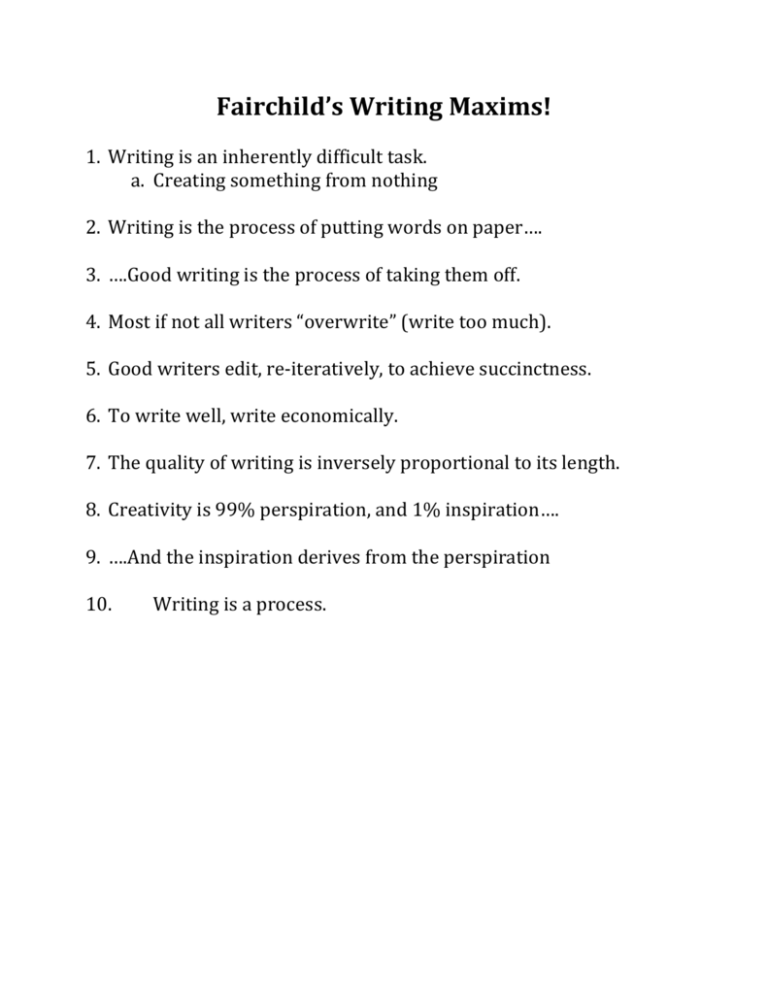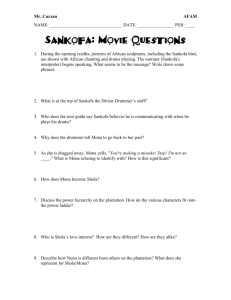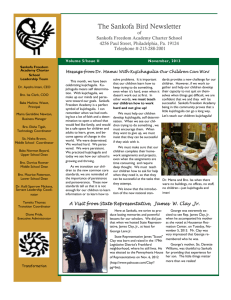Fairchild's Writing Maxims!
advertisement

Fairchild’s Writing Maxims! 1. Writing is an inherently difficult task. a. Creating something from nothing 2. Writing is the process of putting words on paper…. 3. ….Good writing is the process of taking them off. 4. Most if not all writers “overwrite” (write too much). 5. Good writers edit, re-iteratively, to achieve succinctness. 6. To write well, write economically. 7. The quality of writing is inversely proportional to its length. 8. Creativity is 99% perspiration, and 1% inspiration…. 9. ….And the inspiration derives from the perspiration 10. Writing is a process. The Process of Writing a Movie Review 1. Watch the movie 2. Take notes 3. Google search – How to write a movie review 4. Read one or more movie reviews (From Prada to Nada – thesis (“…has more in common with a slapped-together TV movie than a timeless comedy of manners”), characters & plot, conclusion (“a predictable romantic comedy”) 5. Re-incorporate notes Fairchild’s Notes on Sankofa “If the lion wrote history…. The hunter would not be a hero.” Web search: Until Lions write their own history, the tale of the hunt will always glorify the hunter. Notes: The Opening Introductory refrain: “spirt of the dead: Rise up and claim your bird of passage. Those stolen Africans, shackled [on slave ships….] “Tell your story.” The Diaspora: From Mississippi to Brazil, Cuba, Florida, Jamaica, South Carolina, Alabama to Surainam, -- castrated, tarred & feathered, bound & gagged, rise up and posess your bird of passage. Setting – Cape Coast, Ghana. Not a “castle,” but a fort (fortress), note the seaward facing cannon. Mona on the beach and to the Dungeons Note fake hair. Sankofa – staff with Sankofa bird… “Back to your past,” “Return to your source,” on Holy Ground Dungeons – Portuguese, Dutch, British “I’m not an African!” Plantation Life Shola – Hose slave, LaFayette Plantation. Joe & Lucy – romance ? Shola: “If you are born a slave, it is easier to accept things as they are, but we had Nunu Shango (rebels)..” Shango – trouble maker. Wants Shola to poison the family [and all who eat the poisoned food,] Nunu – strength, passion & tenderness. From Africa – living in her past. Joe, her son, a head slave. Mmbling, chanting – cracker killed – haunted by rape scene. That cracker died! Nunu – An Akan Joe & Shola were baptized together. Return of the runaways James (White overseer)– uses Nword Kuta, pregnant, caught, wanted to have her baby in freedom. Notes on slavery & women & their children. Bible Boy – look at that fine lady (Lucy). Sorry, Massa, can’t count whip at the same time.” (form of resistance) Public flogging Flesh as a trap Soldiers, stand firmly behind me. Child birth (juxtaposed with Mona’s branding) Night escapes – Nunu’s story telling – porcupine family, mythical chacter, Afre-e “Special – someone who is born to see” Joe – in Church With Father Raphael. Dungeons with chapels, e.g., Elmina. Madonna & Child, Father Raphael: crucified, nailed to the cross, “for our sins,” Noble Ali – feelin’ bad about Kuta, reminder of his own mother sold…. You can’t be the head man for the white man and not do bad things. (Nunu to Noble Ali). “I’m tired of being a brute – of being head man for the white man, it’s driving me mad.” “Snake eat the frog – we will have to eat what’s in the frog’s belly.” Runways -- & Maroon societies Plotting rebellion in caves. Rape Brave men are scarce. Resistnace News form the hilss: birth of 17 children, 10 boys & 7 girls. We have ten mahetes, 8 forks, and 7 pick axe. All we need is seeks. We will take you away, one by one. [underground railroad] Rebellion – put down by soldiers. A few were rounded up, as examples, put in boxes and placed high in trees until they died. Nunu sold – only to return. PART II The snake will have whatever is in the belly of the frog. ( hhf’s interpretation: A violent suppression of a people’s will, will be overcome only through violence.) “I’M talkin’ to you boy,” “Everything all right, boss,” (Noble Ali). He became “right.” Encounter. Selling of people & family life. Joe: You coward. Nunu returns – too old to be sold. Joe & Fahter R : confession – fight her. “I’m different,” (torment, conflicts, made him mad. He knew he was crazy._) “Who’s son am I? Love potion Nunu – rotten fruit conceived – rape during the Middle Passage Afre-e was Nunu – raped on the slave ship. Cave – planning, initiation rites. Shola ran away, beaten, “heathen, African.” Shango – death preferred. Sankofa bird – a gift. “I became a rebel” [Encounter] Joe’s love potion – he’s sick. Mother’s love. Back at Cape Coast. Diasporic Reunion Spirit of the dead – rise up & possess your bird of passage. IDEAS Birds of passage Quest for identity Preencounter to encounter Nunu never had to; Shango never had to; Noble Ali – when Nunu was sold; Shola, after her runway & beating; Joe, on killing his mother…. Transformations The Lion’s Tale: A Review By Halford H. Fairchild According to an African proverb, “Until Lions write their own history, the tale of the hunt will always glorify the hunter.” Sankofa, written and directed by Haile Gerima—and theatrically released in 1993—is African history from the point of view of the lion. It at once explores the horrors of slavery – its brutality, dehumanization and cruelty – and the indomitable spirit of Africans yearning to be free. Mona, a vivacious model in the modern era, returns to her ancestral past as Shola, a house slave born into slavery on the LaFayette Plantation in the West Indies. Her story is one of transformation – from a quiet acquiescence to slavery’s status quo – to one of rebellion and retribution. And so, too, is the story of the African in America. Shola narrates her story and the stories of 5 emblematic characters. Nunu is the African born, wise and spiritually powerful woman who gives birth to Joe, the offspring of rape on the slave ship. Joe, tormented by the contradictions in his status, finds Christianity an incomplete solution to his madness. Noble Ali, “headman for the White man,” finds salvation in rebellion. Shango, who Shola loves, embodies the rebellious African spirit that cried “death to oppression.” Finally there is James, the White overseer, whose contemptuous disregard for the humanity of his captives led to his own dehumanization – and demise. Sankofa is a powerful film that reveals some truths about capitalism – the wealth of the West was won through an ocean of blood. The conquest of Africa was material, cultural, psychological and theological. Bodies were stolen, cultures were replaced, identities were stripped, and Jesus was Lord. Gerima’s wondrous cinematography provides the connective tissue between the horrors of enslavement with the joys of a liberated identity. When the lions write history, they will discover themselves. [299 words] A Writing Critique Acknowledgements 1. Chelsey Kitazawa, Sunday 2:18 pm 2. Jerzy Kaufman, Sunday, 5:00 pm 3. Emery Hilles, Sunday 9:53 pm 4. Amanda Berry, Sunday, 11:30 pm 5. Jamie Katz, Monday 10:53 a.m. 6. Benjamin Cohen, Monday 1:44 pm 7. Jackson Watts, Monday, 3:58 pm 8. Gregory Wilson, Monday, 4:11 pm 9. Breahna Wilson, Monday, 4:54 pm 10. Ann Belanger, Monday 5:23 pm 11. Clara Lyashevsky, Monday 5:50 pm 12. Scott Martin, Monday 5:52 pm Fairchild’s Writing Maxims! 1. Writing is an inherently difficult task. a. Creating something from nothing 2. “Writing is the process of putting words on paper…. 3. ….Good writing is the process of taking them off.” 4. Most if not all writers “overwrite” (write too much). 5. Good writers edit, re-iteratively, to achieve succinctness. 6. To write well, write economically. 7. The quality of writing is inversely proportional to its length. 8. Creativity is 99% perspiration, and 1% inspiration…. 9. ….And the inspiration derives from the perspiration 10. Writing is a process. Original In the film “Sankofa,” director Haile Gerima attacks a topic many will not touch: the enslavement of the African people. His 1993 drama opens with the glorious West African beaches, in a seemingly colorblind society as a white man poses a photo shoot with an African-American woman. Almost immediately an African man in traditional garb comes up to the couple, screaming at them in Akan, the words which they cannot understand but the tone of anger is undeniable. He screams at the white man to leave the sacred land and insists that the black woman return to her roots. This man is the Sankofa, the guardian of the grounds, who supposedly communicates for spirits of the dead, the actual word meaning “go back and fetch.” This definition proves extraordinarily accurate as [131 words] [the paragraph continues for a total of 299 words] Edited Haile Gerima’s Sankofa (1993) addresses a taboo topic: the enslavement of African people. His historical drama opens with scenes of glorious West African beaches, on which a White photographer and an AfricanAmerican female model have a photo shoot in the shadows of the dungeons that had housed captive Africans in centuries past. A traditional African man, the selfappointed guardian of the “castle,” tells the photographer (and other White tourists) to leave the sacred land and the Black woman to return to her roots. The self-appointed guardian is named Sankofa, which means “go back and fetch.” This definition accurately reflects the storyline… 101 words [½ of the essay was devoted to the first 5 minutes of the film. Mundane description, lacking any sense of a premise in the making.] Soon after Mona finishes modeling for pictures she walks to the After the modeling session, Mona enters the dungeons previously dungeon of the fort which used to be a used as a holding cell for slaves holding cell for slaves not yet taken to awaiting shipment to the New World. the new world. In a discomforting She is thrust back in time to the 18th transition the fort returns to its 18th century, with the dungeon is full of century form and the dungeon is full shackled Africans. She tries to escape of young Africans in shackles. Mona but is captured, branded, and enslaved. tries to escape but is stopped by [50 words] European captors and subsequently stripped, beaten and enslaved. [69 words] …. Joe is half black, half white and caught Joe--half Black, half White--is caught in the middle of an identity crisis. He in an identity crisis. As a head slave, is a head slave and feels more loyalty he feels more loyalty to the masters to the masters and the church than his and the church than his own people. own people. Several times he refers to He refers to the enslaved women as the enslaved women as heathens, as a “heathens,” the result of brainwashing result of brainwashing by the priest he by a respected priest. greatly respects. It is not until Joe kills his mother that he realizes that his When Joe kills his mother he realizes loyalty should belong to his people, that his loyalty should belong to his not to the enemy and that being a head people. Being a head slave does not slave does not mean you are not a mean you are not human. Joe slave. Joe is as important a character epitomizes the identity struggles that as anyone in the film, he epitomizes people of color have faced for the identity struggles that people of centuries. [84 words] ambiguous race have faced for hundreds of years. [119 words] Randomly selected: Sankofa explores almost every aspect of slavery, many of which the majority of the public have never even considered. We witness the brutality between the white owners and the black house slaves, as Mona is repeatedly beaten and raped, but also the forced hostility between the black house slaves and the field slaves. Slaves who attempt to run away are given lashings by their own kinsman, which creates a social divide between the house and field slaves. Sankofa also conveys the importance of Christianity and religion in the film. The slaves are considered savages by the white man for praying to their own “African god.” A corrupt priest, who manipulates religion to further push the acceptance of enslaving the “savages” and dehumanizing their culture, teaches a few house slaves a poised version of Christianity. This in itself touches on subjects many people do not associate to slavery, and Gerima does an excellent job expressing that slaves were not only abused physically, but mentally and spiritually as well. (167 words, paragraph randomly selected) Sankofa explores slavery in ways unknown to the majority of the public. We witness the brutality between the White owners and the Black house slaves, as Mona is repeatedly beaten and raped. We also see the hostility between the house and field slaves. Runaways were lashed by their own kinsman, creating more social division. between the house and field slaves. Sankofa conveys the importance of Christianity and religion: The slaves are considered savages for praying to their “African god.” A corrupt priest, manipulates religion to justify slavery and delegitimating humanizing their culture. Gerima does an excellent job showing that slaves were abused physically, mentally and spiritually. (99 words)






